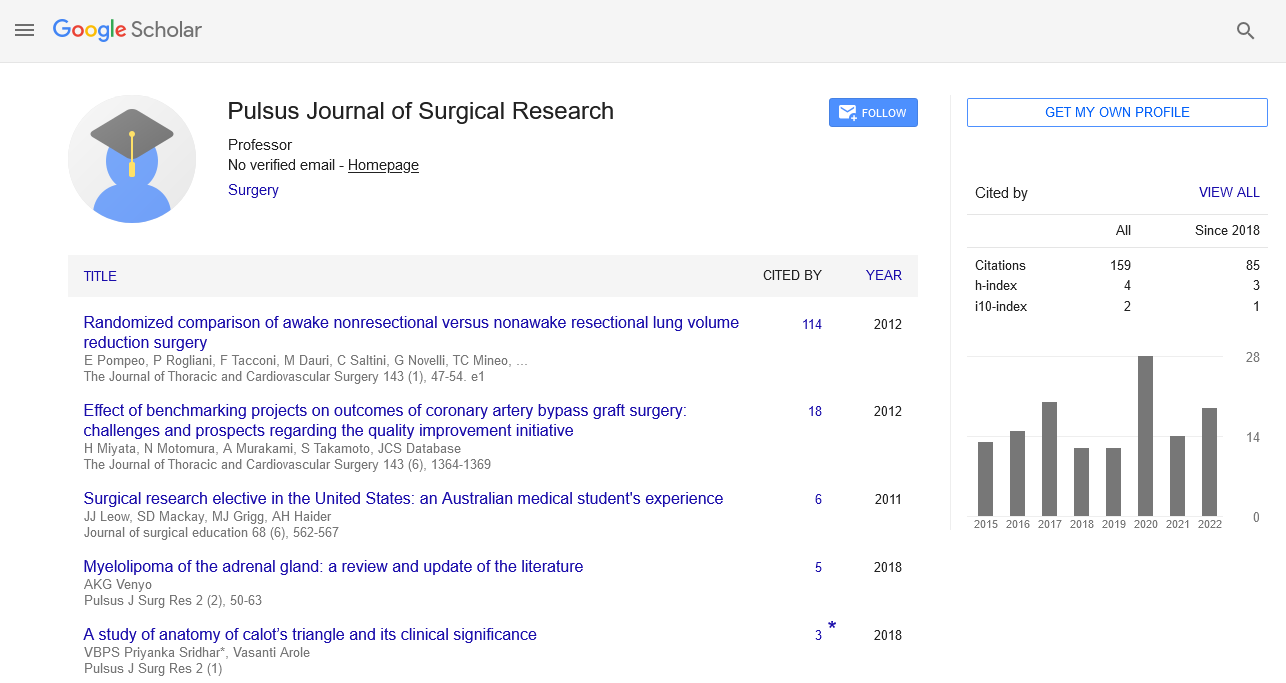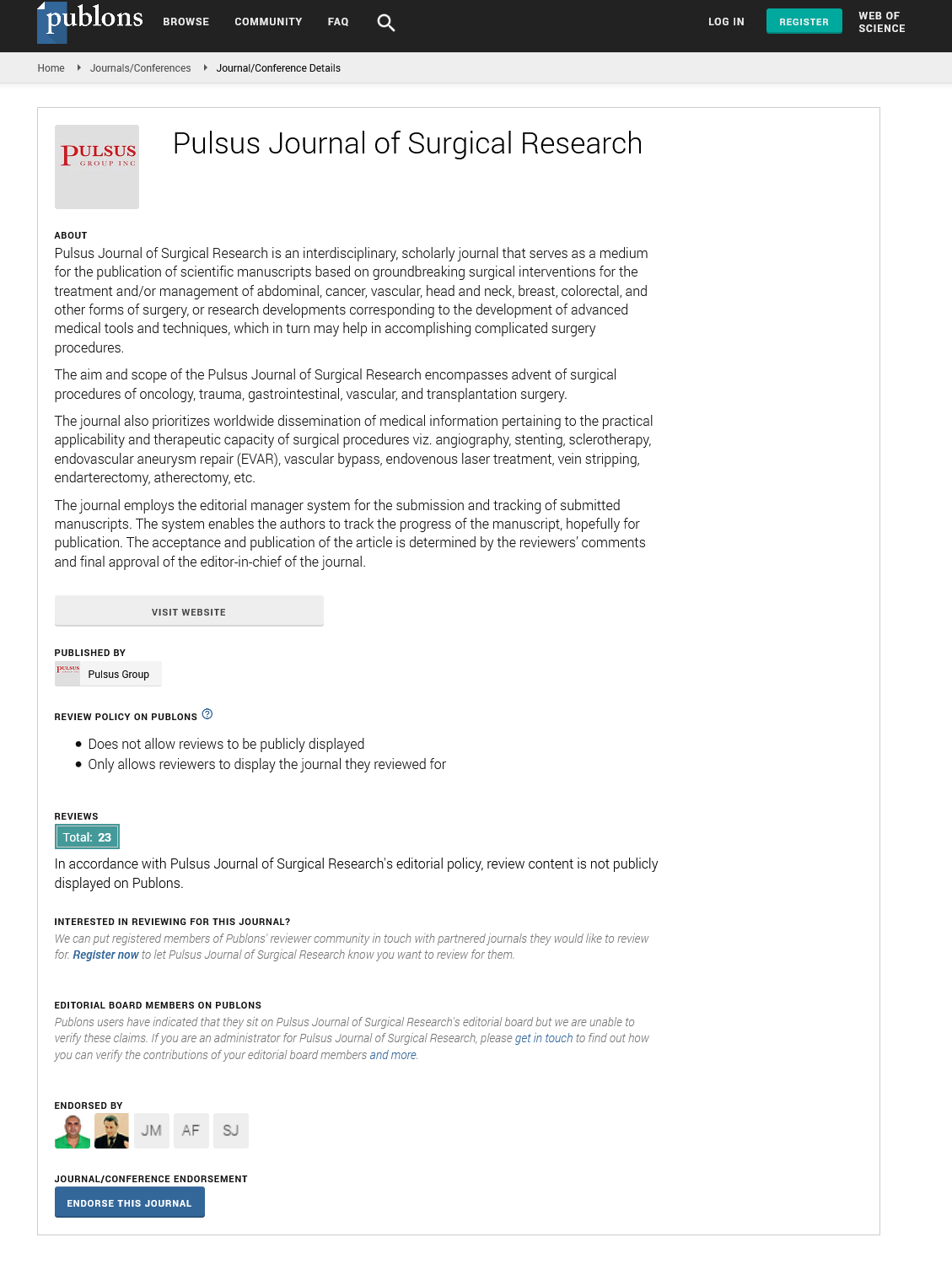Pyrrolizidine alkaloids have been found in jammu that is sold in indonesia, along with an evaluation of their safety for human ingestion
Received: 03-Apr-2022, Manuscript No. pulpjsr-22--5645; Editor assigned: 06-Apr-2022, Pre QC No. pulpjsr-22-5645 (PQ); Accepted Date: Apr 26, 2022; Reviewed: 18-Apr-2022 QC No. pulpjsr-22-5645 (Q); Revised: 24-Apr-2022, Manuscript No. pulpjsr- 22-5645 (R); Published: 30-Apr-2022
Citation: Malovie S. Pyrrolizidine alkaloids have been found in jammu that is sold in indonesia, along with an evaluation of their safety for human ingestion. J surg Res. 2022; 6(2):19-21.
This open-access article is distributed under the terms of the Creative Commons Attribution Non-Commercial License (CC BY-NC) (http://creativecommons.org/licenses/by-nc/4.0/), which permits reuse, distribution and reproduction of the article, provided that the original work is properly cited and the reuse is restricted to noncommercial purposes. For commercial reuse, contact reprints@pulsus.com
Abstract
The presence of pyrrolizidine alkaloids (PAs) and associated hazards in Indonesian Jammu were assessed. From 12.3 g/kg -235,376 g/kg of PAs were found in 34 of 35 jamus that contained PA-producing botanicals. 17 out of 23 Jammu-produced non-PA-producing botanicals had a total PA level of 5.9 g/kg -3,421 g/kg, indicating contamination with PAproducing plants. Although one sample would surpass an intake of 10 g PA/kg BW/day, which may cause hepatic veno-occlusive disease (HVOD) in humans, short-term ingestion of Jammu is unlikely to have acute harmful consequences. A priority for risk management is indicated when assuming daily lifelong use because the risk assessment for the genotoxic and carcinogenic potential of PAs revealed Margin of Exposure (MOE) values < 10,000 for 27 out of all samples examined (46.6%). Using Haber's criterion and the assumption that intake occurs for two weeks annually throughout one's lifespan, 13 out of 35 Jammu samples (or 37% of the total) still pose a priority, but the Jammu made up of non-PA-producing botanicals would be of low priority. Due to the presence of hazardous PAs in Jammu, this study's findings can help Indonesian risk management efforts to reduce the possible health risk to consumers.
Key Words
Market Cells; Surgical Care; Oncology; Hepatobiliary; Esophagostomy.
Introduction
One of Indonesia's traditional herbal medicinal methods is known Oas Indonesian Jammu. The majority of Jammu products on the market have the labeling BPOM RI TR, where TR denotes the product category of obat traditional produksi Dalam Negeri (Indonesian traditional medicine), and BPOM RI denotes the regulatory body where the product is registered, the Badan Peng was Obat Dan Makanan Republic Indonesia (BPOM, 2016). Jammu is available in several different forms, including Simplicial (dried/fresh raw Jammu botanicals) and powder, tablet, pill, caplet, and capsule. The simplicity and Jammu in powder form can be easily eaten by mixing them with hot water and drinking the resulting concoction, whereas the other forms can be taken straight as a supplement. BPOM RI is closely observing the quality, safety, and efficacy of the products in light of the rising demand for Jammu in both domestic and foreign markets. But knowledge gaps concerning the potential health impacts of dangerous medications and/or poisonous components in Jammu now limit its monitoring activity [1]. Customers may be at risk due to this vulnerability, particularly if they frequently use Jammu. Compounds that are genotoxic and carcinogenic, which may be present naturally in the botanical elements of Jammu and hence may present a safety problem, are among the botanical constituents of particular concern. For instance, in our earlier research, alkenyl benzene (AB) methyl eugenol was found in 91.3% of the Jammu samples that tested positive for ABs, suggesting that it was a significant component. Margin of Exposure (MOE) values of typically 10,000 were obtained after quantifying methyl eugenol levels and exposure resulting from usage of the corresponding Jammu products, indicating a need for risk management when assuming daily use over a lifetime [2]. Aristolochic acids (AAs), which can appear in plant food supplements (PFS) and herbal products at amounts that constitute a health risk for their customers, are another class of genotoxic substances. According to a review of the literature, herbal products containing AA-1 and AA-II should be given priority for risk management because the MOEs for 206 out of 573 (35.9%) of the samples studied were below 10,000 due to the levels of AA-1 and AA-II reported in chosen PFS. Pyrrolizidine alkaloids (PAs), according to recent findings on PFS, may represent a third class of problematic plant components. The current study's objectives included a risk assessment and an investigation of the potential existence of PAs in Jammu. Acute exposure to PAs in people can result in hepatic veno-occlusive disease (HVOD), which causes significant liver damage and, in rare cases, can be fatal [3]. Chronic exposure, on the other hand, can develop liver cirrhosis and pulmonary arterial hypertension.
Furthermore, it revealed that the identified PAs in various botanical goods, such as herbal teas, herbal medications, and food supplements, came from contamination of the non-PA-containing plant material used to make the products with PA-containing weeds during their cultivation or collection. The European Medicines Agency (EMA) developed risk management measures to lower this degree of contamination in response. A transitional intake limit of 1.0 g PA per day per person has been set by the Herbal Medicinal Products Committee (HMPC) of the EMA in relation to consumption brought on by such contamination. A consensus to extend the transitional time was recently announced by HMPC. The EFSA Panel on Contaminants in the Food Chain (CONTAM Panel) determined a lower confidence limit of the benchmark dose resulting in a 10% extra cancer risk (BMDL10) of 237 g/kg body weight per day as the point of departure for calculating the MOE. This lower confidence limit was derived from tumor data on ridgeline (EFSA). The goal of the current study is to look into the presence of PAs in 58 Jammu products from Indonesia that comprise different blended medicinal botanicals, including 35 samples that contain botanicals that produce PA and 23 samples that do not. A safety evaluation of consuming this Jammu was conducted based on the levels of PAs present and the usage instructions provided by the producers. The study's findings can aid risk management in creating regulatory measures to reduce PA exposure through the use of Jammu [4]. A focused sampling strategy was used to gather 58 samples of Jammu from various brands. As shown, the samples were acquired from Jammu stores or conventional marketplaces in Indonesia. A group of 23 samples that, according to the label, did not include PAproducing botanicals were used in study 58 to check for potential contamination of Jammu with PA-producing plants. 21 of these samples were already collected and analyzed for ABs, and two samples from the targeted sampling exercise were added because their labels suggested the presence of botanicals that produce aristolochic acid (AA). Supplementary Material provides an overview of the specific botanicals of concern that were present in the samples, as well as the label's health claims and suggested daily dosage. The capsule samples were opened first, and only the weighted contents inside were weighed before being placed into the plastic bag with the powder samples. The sample pills and caplets were weighed, then the powder was created by grinding them in a mortar and collecting it in a plastic bag. The water used had a minimum resistance of 18.2 M and was deionized MilliQ. Act-all provided methanol (LC-MS grade) and acetonitrile (LC-MS grade) (Oss, the Netherlands). Sigma-Aldrich provided formic acid (analytical grade, 99-100%) and ammonium carbonate (analytical grade) (Zwijndrecht, the Netherlands). A total of 59 PA analytical standards were obtained from Photoplay in Heidelberg, Germany, with the exception of heliotrope and trichodesmine, which were obtained from Laotian in Valence, France; usaramine from BOC Sciences in Shirley, New York, USA; florosenine from PRISMA in Leiden, the Netherlands; and thymidine, indicine, indicine N-oxide, intermediate, intermediate N-oxide, Lycos (Vestenbergsgreuth, Germany). The process was used to internally manufacture usaramine N-oxide, spartioidine N-oxide, and trichodesmine N-oxide. In the Supplementary Material, a comprehensive list of the PA standards used in this work is provided. The extraction method was used for the analysis of herbal teas and herbal medicines and was based on an internally approved approach. Jammu was briefly treated with a formic acid solution, followed by 30 minutes of agitation in a rotary tumbler. Prior to extraction, the mixed PA standard solution was added to one of the test parts. The EDI and MOE values were calculated using the interim Relative Potency factors as described by Merz and Schrenk, to express the PA levels and EDI values in ridgeline equivalents [5]. This was done to account for the variations in relative potency between the PAs discovered in the Jammu samples. The MOE values were calculated for lifetime exposure, for exposure for two weeks each year over a lifetime, and for the number of weeks during which the Jammu might be used to produce a MOE value using the EDI values thus acquired. All Jammu samples that contained both PA-producing and non-PA-producing botanicals had EDI values for PAs that were far lower than the dose range of 1 mg PA/kg BW/day -3 mg PA/kg BW/day at which acute/short-term negative effects in humans have been documented. This finding suggests that users of Jammu who drink those preparations for brief periods of 4 days to 2 weeks are not at risk for acute toxicity of PAs. The EDI value in one Jammu sample, TR-17, is more than 10 g/kg BW/day, though, and this has been connected to the occurrence of HVOD in humans (WHO-IPCS, 1988). In order to determine whether there is a potential health concern for users of these preparations, this study compared the levels of pyrrolizidine alkaloids in Jammu containing PA-producing botanicals versus Jammu having non-PA-producing botanicals. The growing popularity of Jammu and the possibility that its botanical constituents contain PAs, which have hepatotoxic, genotoxic, and carcinogenic effects, raise the importance of this assessment [6]. It's interesting to note that while half of these Gynura products had high PA levels, the other half had comparatively low amounts. Otonecinetype PAs including senkirkine, neosenkirkine, dehydrosenkirkine, and other otonecine-type analogs predominate in several of the Jammu samples derived from Gynura that contain significant PA levels [7]. These samples also contain significant amounts of the PAs senecionine and integerrimine.
References
- Chen L, Mulder PP, Peijnenburg A, et al. Risk assessment of intake of pyrrolizidine alkaloids from herbal teas and medicines following realistic exposure scenarios. Food Chem. Toxicol. 2019; 130:142-53.
- Chen L, Mulder PP, Louisse J, et al. Risk assessment for pyrrolizidine alkaloids detected in (herbal) teas and plant food supplements. Regul Toxicol Pharmacol..2017;86:292-302.
- Miettinen M, Sarlomo-Rikala M, Lasota J. Gastrointestinal stromal tumors: recent advances in understanding of their biology. Hum Pathol. 1999; 30(10):1213-20.
- Pidhorecky I, Cheney RT, Kraybill WG, et al. Gastrointestinal stromal tumors: current diagnosis, biologic behavior, and management. Ann SurgOncol.2000;7(9):705-12.
- Blay JY, von Mehren M, Blackstein ME. Perspective on updated treatment guidelines for patients with gastrointestinal stromal tumors. Cancer. 2010;116(22):5126-37.
- Mochizuki Y, Kodera Y, Ito S, et al. Treatment and risk factors for recurrence after curative resection of gastrointestinal stromal tumors of the stomach. World j surg. 2004; 28(9):870-5.
- Fong Y, Coit DG, Woodruff JM, et al. Lymph node metastasis from soft tissue sarcoma in adults. Analysis of data from a prospective database of 1772 sarcoma patients. Annals of surgery. 1993; 217(1):72.






